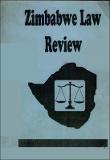| dc.contributor.author | Chiroro, Patrick | |
| dc.contributor.author | Sithole, Stabiso | |
| dc.contributor.author | Muromo, Tinashe | |
| dc.coverage.spatial | Zimbabwe | en |
| dc.date.accessioned | 2015-08-18T09:34:26Z | |
| dc.date.available | 2015-08-18T09:34:26Z | |
| dc.date.issued | 1997 | |
| dc.identifier.citation | Chiroro, P., Sithole, S. and Muromo, T. (1997) Children and Adults' Memory for Faces: Implications for Face Identification Procedures in Criminal Investigations. Zimbabwe Law Review (ZLRev.), vol. 14, (pp. 74-87). UZ, Mt. Pleasant, Harare: Faculty of Law (UZ) | en |
| dc.identifier.uri | https://opendocs.ids.ac.uk/opendocs/handle/20.500.12413/6777 | |
| dc.description | A ZLRev. article on the legal pros and cons of face identification parades in criminal investigations. | en |
| dc.description.abstract | Witnesses to a crime are often required to identify a suspect from a police line-up or photo spread. Positive identification of a suspect made under oath and with confidence by one or more witnessess is usually considered to be strong evidence that the suspect is indeed the criminal. However, cases of mistaken identity sometimes do occur, often with disasterous consequences for the misidentified persons and their families (e.g. the cases of John Demjanjuk, Laszlo Virag, Frank Walus & Marinus de Rijke — see Wagenaar, 1988, pp 1- 30). In recent years, applied research on the psychological processes involved in human memory has contributed significantly to our understanding of the sources of erroneous identifications in criminal investigations. However, research on developmental trends in face identification ability has been sparse. In this article, we report the results of two experiments in which children and adults's face recognition and identification performance were examined. Findings from both experiments showed that: (i) face recognition performance and face identification ability are skills that develop and improve as a function of increasing age, (ii) the probability of false recognitions occurring in a police line-up or photo spread is smaller for faces with distinctive features and/or feature configurations than it is for typical or 'average-looking' faces, and (iii) when the 'to-be-remembered' face is distinctive in appearance, children as young as 6-7 years are no more likely to make face identification errors than are adults. The practical implications of these findings for face identification procedures in criminal investigations are discussed. | en |
| dc.language.iso | en | en |
| dc.publisher | Faculty of Law, University of Zimbabwe (UZ) | en |
| dc.rights.uri | http://creativecommons.org/licenses/by-nc-nd/3.0/ | en |
| dc.subject | Children and Youth | en |
| dc.subject | Rights | en |
| dc.subject | Social Protection | en |
| dc.title | Children and Adults' Memory for Faces: Implications for Face Identification Procedures in Criminal Investigations | en |
| dc.type | Article | en |
| dc.rights.holder | University of Zimbabwe (UZ) | en |


